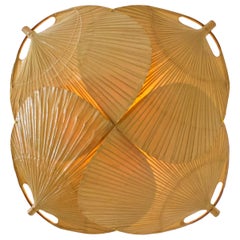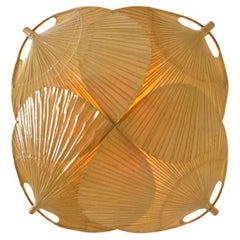Flushmount Ingo
Recent Sales
20th Century German Mid-Century Modern Flush Mount
Bamboo, Wood, Paper
20th Century German Mid-Century Modern Flush Mount
Bamboo, Wood, Paper
Ingo Maurer for sale on 1stDibs
German designer Ingo Maurer (1932–2019) was known as a “poet of light” for how he artfully created lamps that married form and function, from bulbs that soared on goose-feather wings to chandeliers that suspended bursts of shattered tableware like a slow-motion explosion. One of his first lamps, a 1966 design that was merely called Bulb, nested a lightbulb inside a larger glass lightbulb shape, drawing on his connection to German art traditions of reductive forms as well as Pop art and the playful aesthetics of 1960s pop culture. The success of Bulb — its fans included American design icon Charles Eames — led to the founding of his own company to produce this provocative fixture as well as other fantastic lighting designs.
Born on the island of Reichenau in Lake Constance in southern Germany, Maurer apprenticed at a newspaper before moving to the United States in 1960. In New York and California, Maurer initially worked as a graphic designer for IBM and elsewhere before returning to Germany with his then-wife, designer Dorothee Becker, in 1963. The experience that Maurer gained in typography and bold forms was regularly expressed in the lamps crafted by his company, which was called Design M before the name was changed to Ingo Maurer GmbH. The lighting manufacturer is still based in Munich.
Some of Maurer’s pieces were minimal, such as a ceramic table lamp in 1996 he called Broken Egg, which radiated light from a fissure in an oblong shape, while others were monumental, such as the designer’s last completed installation — a colossal chandelier composed of over 3,000 silver-plated leaves — in Munich’s Residenztheater. Maurer was always at the forefront of lighting innovations, exploring holograms, LEDs and OLEDs in his projects. Through his company, the venturesome Maurer also promoted inventive new designers, including Moritz Waldemeyer, whose My New Flame (2012) imagined a futuristic candle with LEDs.
Ingo Maurer GmbH continues to produce the late designer’s distinctive table lamps, chandeliers and other fixtures, including the imaginative Bulb that started it all.
Find a collection of Ingo Maurer lighting designs on 1stDibs.
A Close Look at mid-century-modern Furniture
Organically shaped, clean-lined and elegantly simple are three terms that well describe vintage mid-century modern furniture. The style, which emerged primarily in the years following World War II, is characterized by pieces that were conceived and made in an energetic, optimistic spirit by creators who believed that good design was an essential part of good living.
ORIGINS OF MID-CENTURY MODERN FURNITURE DESIGN
- Emerged during the mid-20th century
- Informed by European modernism, Bauhaus, International style, Scandinavian modernism and Frank Lloyd Wright’s architecture
- A heyday of innovation in postwar America
- Experimentation with new ideas, new materials and new forms flourished in Scandinavia, Italy, the former Czechoslovakia and elsewhere in Europe
CHARACTERISTICS OF MID-CENTURY MODERN FURNITURE DESIGN
- Simplicity, organic forms, clean lines
- A blend of neutral and bold Pop art colors
- Use of natural and man-made materials — alluring woods such as teak, rosewood and oak; steel, fiberglass and molded plywood
- Light-filled spaces with colorful upholstery
- Glass walls and an emphasis on the outdoors
- Promotion of functionality
MID-CENTURY MODERN FURNITURE DESIGNERS TO KNOW
- Charles and Ray Eames
- Eero Saarinen
- Milo Baughman
- Florence Knoll
- Harry Bertoia
- Isamu Noguchi
- George Nelson
- Danish modernists Hans Wegner and Arne Jacobsen, whose emphasis on natural materials and craftsmanship influenced American designers and vice versa
ICONIC MID-CENTURY MODERN FURNITURE DESIGNS
- Eames lounge chair
- Nelson daybed
- Florence Knoll sofa
- Egg chair
- Womb chair
- Noguchi coffee table
- Barcelona chair
VINTAGE MID-CENTURY MODERN FURNITURE ON 1STDIBS
The mid-century modern era saw leagues of postwar American architects and designers animated by new ideas and new technology. The lean, functionalist International-style architecture of Le Corbusier and Bauhaus eminences Ludwig Mies van der Rohe and Walter Gropius had been promoted in the United States during the 1930s by Philip Johnson and others. New building techniques, such as “post-and-beam” construction, allowed the International-style schemes to be realized on a small scale in open-plan houses with long walls of glass.
Materials developed for wartime use became available for domestic goods and were incorporated into mid-century modern furniture designs. Charles and Ray Eames and Eero Saarinen, who had experimented extensively with molded plywood, eagerly embraced fiberglass for pieces such as the La Chaise and the Womb chair, respectively.
Architect, writer and designer George Nelson created with his team shades for the Bubble lamp using a new translucent polymer skin and, as design director at Herman Miller, recruited the Eameses, Alexander Girard and others for projects at the legendary Michigan furniture manufacturer.
Harry Bertoia and Isamu Noguchi devised chairs and tables built of wire mesh and wire struts. Materials were repurposed too: The Danish-born designer Jens Risom created a line of chairs using surplus parachute straps for webbed seats and backrests.
The Risom lounge chair was among the first pieces of furniture commissioned and produced by legendary manufacturer Knoll, a chief influencer in the rise of modern design in the United States, thanks to the work of Florence Knoll, the pioneering architect and designer who made the firm a leader in its field. The seating that Knoll created for office spaces — as well as pieces designed by Florence initially for commercial clients — soon became desirable for the home.
As the demand for casual, uncluttered furnishings grew, more mid-century furniture designers caught the spirit.
Classically oriented creators such as Edward Wormley, house designer for Dunbar Inc., offered such pieces as the sinuous Listen to Me chaise; the British expatriate T.H. Robsjohn-Gibbings switched gears, creating items such as the tiered, biomorphic Mesa table. There were Young Turks such as Paul McCobb, who designed holistic groups of sleek, blond wood furniture, and Milo Baughman, who espoused a West Coast aesthetic in minimalist teak dining tables and lushly upholstered chairs and sofas with angular steel frames.
As the collection of vintage mid-century modern chairs, dressers, coffee tables and other furniture for the living room, dining room, bedroom and elsewhere on 1stDibs demonstrates, this period saw one of the most delightful and dramatic flowerings of creativity in design history.
Materials: bamboo Furniture
Bamboo — the reed-like, woody grass revered the world over for its attractiveness, durability and unbeatable versatility — has a purity and elegance that Ming Dynasty dignitaries, European royals and workaday folks alike have appreciated for centuries. Antique and vintage bamboo furniture can help introduce an air of relaxation in any space, and pairs well with chinoiserie decor and a range of porcelain decorative objects.
So why is bamboo — in its many forms — so enduringly popular? The grass itself is classic-looking and pleasingly geometric, and it evokes a subtle exoticism that’s both glamorous and (due in large part to its sustainability) highly attainable.
Bamboo is harder than mahogany. It’s a rigid and hollow reed, and as such it is not rattan, which is dense, steamable and bendable, and has become its own ultimate decorative-arts chameleon over the years. But like rattan, bamboo is an organic material that provides a link to nature, helping us to bring a bit of the outside in, in an elegant yet no-frills way that seems comforting and familiar. Plus, bamboo’s lightness and slight irregularities make it the perfect counterpoint to heavy-feeling interiors.
For organic modern interiors — or any space that would benefit from a dose of the natural world — a variety of vintage bamboo outdoor furniture, side tables, dining chairs and more can be found on 1stDibs.
Finding the Right flush-mount-ceiling-lights for You
Antique and vintage flush mount lighting fixtures can help you create inviting, ambient lighting in your space, and who doesn’t want that?
While electric light bulbs were a huge improvement over gas and oil lamps for lighting our homes, we still had much work to do in order to arrive at the broad range of table lamps, pendants, sconces and other fixtures that are available today.
Lighting technology and design improved substantially over time. Engaging engineers, scientists, architects and designers alike, the field of lighting became a major proving ground for state-of-the-art materials like plastics, inventive new mechanisms and emotionally resonant styles that included the ethereal (Isamu Noguchi’s Akari light sculpture), the whimsical (Gino Sarfatti’s 2109 ceiling light and Sputnik chandelier) and the eclectically postmodern (the Toio floor lamp crafted by Achille and Pier Giacomo Castiglioni). Eventually, flush mount light fixtures became a practical option for home lighting.
Flush mount lighting fixtures are among the most convenient ways to light a small room with a low ceiling. These structures sit directly against the ceiling’s surface and cast light downward, illuminating a large area and defining the room. Semi-flush mount lighting fixtures hang several inches from the ceiling. They also produce ambient light but can be a little more decorative and lean toward the style of chandeliers.
Flush mount lighting is versatile. Larger fixtures distribute more ambient light across the center of the room, while smaller flush mount fixtures are best for accent or task lighting. The main drawback of flush mount fixtures is that they don’t make a strong statement. You can remedy this by strategically arranging decorative accents that flourish in soft lighting.
Lighting is an essential part of any interior design project. Often, having the right light fixture is key to creating an attractive, radiant room. Ample lighting paired with enticing design creates an elevated, inviting atmosphere, helping to set the desired mood. Selecting the right lighting for your home, however, isn’t merely about creating an especially bright bedroom or a moody dining room. There are many different kinds of fixtures and illumination to consider, with flush mount lighting fixtures among them.
Make a statement with a<a href=/furniture/lighting/flush-mount-ceiling-lights/material/metal/ target="_blank" rel="noopener noreferrer"> metal flush mount lighting fixture — a copper or chrome fixture can prove dazzling in your living room. Art Deco flush mount lighting fixtures, with their geometrical shapes and unique detailing in crystal, glass and brass, will go toward creating a cohesive look amid your collection of authentic Art Deco era posters and other wall decor.
Hollywood Regency fixtures — defined by a flamboyant design style for which we credit decorator Dorothy Draper — can introduce glamour and glitz to your living room with their mirrored finishes and complex floral motifs.
Explore a collection of antique and vintage flush mount lighting fixtures on 1stDibs to see what style best suits your space.

